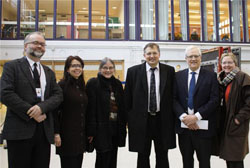Feb 22 2009
Norwegian university ready for a giant leap towards greener footprints. Architects, engineers and entrepreneurs join forces to create zero emission buildings.
 The Norwegian Minister of Petroleum and Energy Terje Riis-Johansen visits the ZEB lab, February 12. Left to right: Terje Jacobsen (SINTEF), Marit Thyholt (SINTEF), Anne Grete Hestnes (NTNU), Terje Riis-Johansen (Minister of Petroleum and Energy), Torbjørn Digernes (Rector, NTNU), Unni Steinsmo (CEO, SINTEF).
The Norwegian Minister of Petroleum and Energy Terje Riis-Johansen visits the ZEB lab, February 12. Left to right: Terje Jacobsen (SINTEF), Marit Thyholt (SINTEF), Anne Grete Hestnes (NTNU), Terje Riis-Johansen (Minister of Petroleum and Energy), Torbjørn Digernes (Rector, NTNU), Unni Steinsmo (CEO, SINTEF).
Earlier this month, the Norwegian government assigned The Faculty of Architecture and Fine Art at the Norwegian University of Science and Technology to host one out of eight new national Centers for Environment-friendly Energy Research.
Over the next 8 years, starting up on March 2nd 2009, The Research Centre on Zero Emission Buildings (ZEB) are granted an annual budget of 4,5 million euros.
The 40 % industry
The building industry is often referred to as “the 40 % sector” in an environmental context. 40 % of all use of materials and products are related to buildings. And both worldwide and in Europe buildings account for about 40 % of all primary energy use and therefore contribute to significant greenhouse gas emissions.
Reducing the demand for energy may be more cost-efficient than extending the capacity in the energy supply system. A combination of making buildings more energy-efficient and use a larger fraction of renewable energy is therefore a key issue to meet the global challenges related to climate change and resource shortages.
Saving energy more efficient than producing new energy
The main objective of ZEB is to develop competitive products and solutions for existing and new buildings that will lead to market penetration of buildings that have zero emissions of greenhouse gases related to their production, operation and demolition. The Centre will encompass both residential and commercial buildings, as well as public buildings.
- Energy efficiency is better and cheaper than producing new energy; one kWh saved equals at least two kWhs produced energy. So reducing the energy consumption related to both existing and future building stock complements the broad international research on new renewable energy sources, says professor Anne Grete Hestnes, head of the ZEB-center at Norwegian University of Science and Technology.
Strong partnership
ZEB has entered a binding partnership with the Norwegian Research Council, SINTEF, industrial partners and a strong consortium of international partners like MIT, Fraunhofer, Tsinghua University and Chalmers.
Several of the R&D environments in ZEB are in the forefront of international research within their fields. ZEBs combined expertise within material science, building technology, renewable energy, architecture and social sciences represent a real competitive edge.
The industrial partners, including Skanska, Glava and Isola, employ 100.000 people and total an annual turnover worth 25 billion euros.